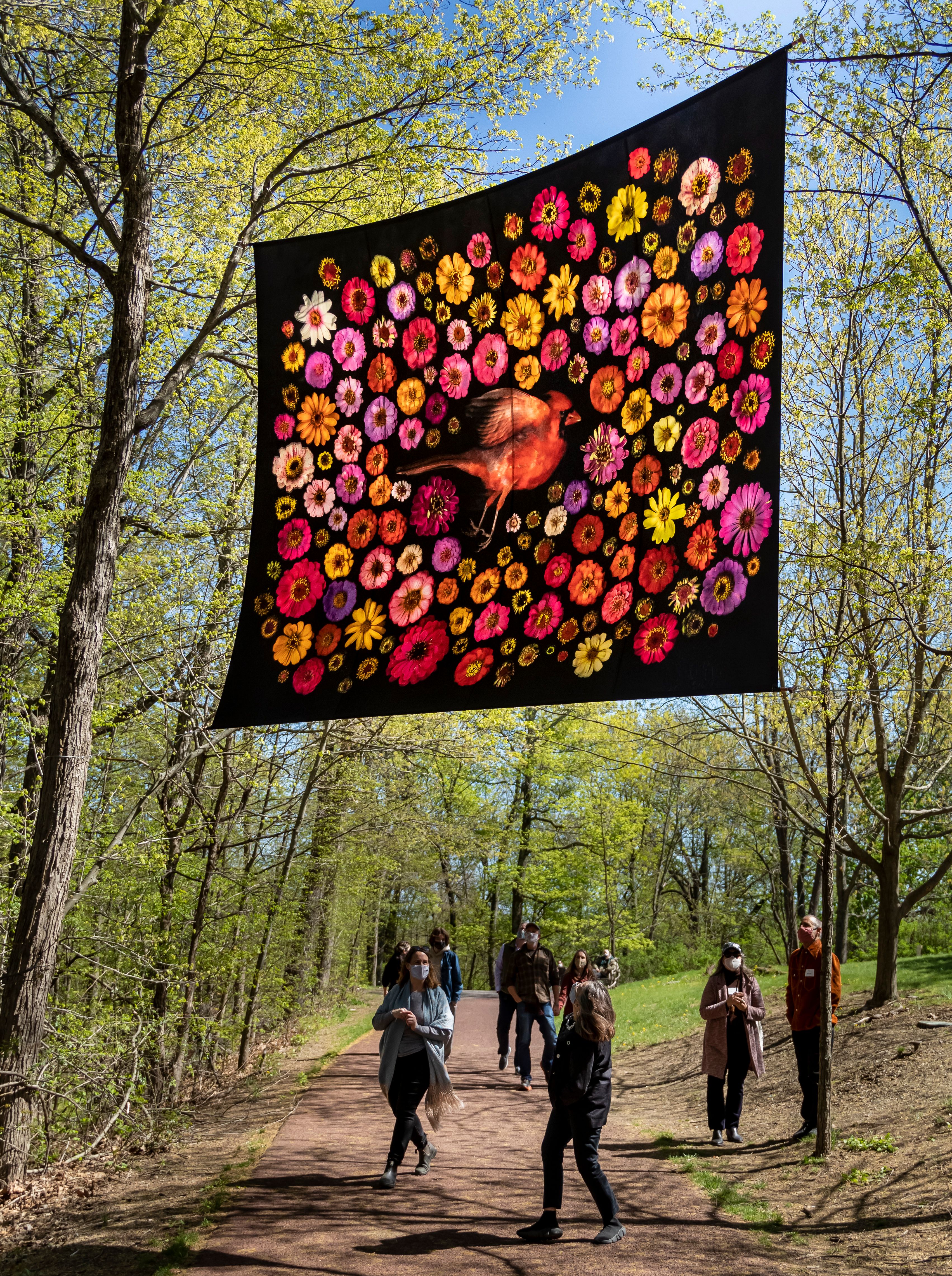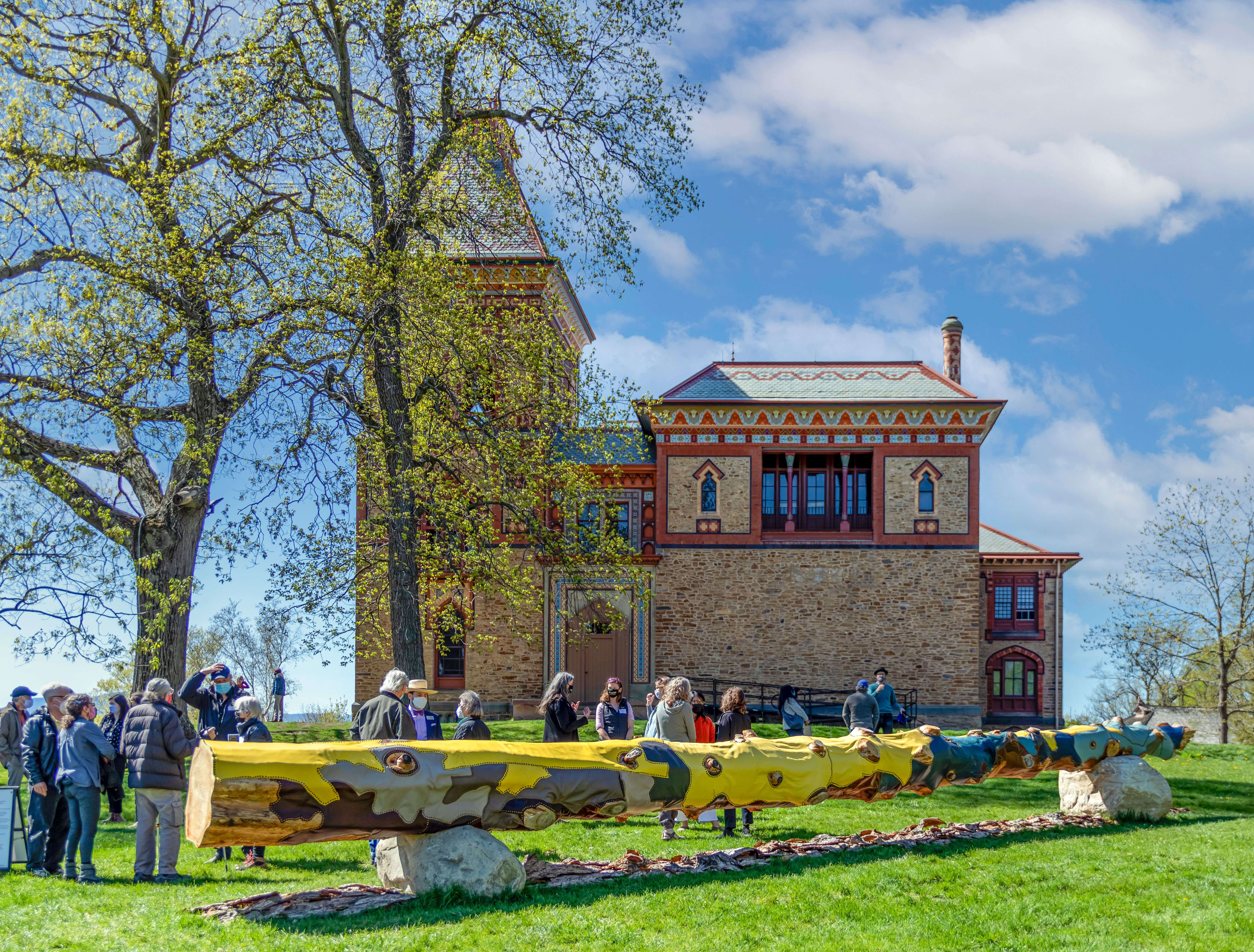In "Cross Pollination," Art And Environment Meet At Olana And Cole House
"Cross Pollination" brings together the ecological work of three masters and contemporary artists for an impactful exhibition.

"Cross Pollination" brings together the ecological work of three masters and contemporary artists for an impactful exhibition.

Martin Johnson Heade, "Hooded Visorbearer," ca. 1863–64
"Cross Pollination: Heade, Cole, Church, and Our Contemporary Moment" is a collaborative exhibition on display now through October 31 at both the Olana and Thomas Cole House historic sites in Hudson and Catskill, New York, respectively. After nearly five years in the making, the installation is a stunning statement about our human relationship with nature, from gentle gaze to reckless destruction.
The nucleus of the show is Martin Johnson Heade’s 19th-century painting series of South American hummingbirds, “The Gems of Brazil,” on loan from the exhibition’s third major collaborator, the Crystal Bridges Museum of American Art in Bentonville, Arkansas. With their magical pops of iridescence, enhanced by rose madder in a way only truly appreciated when viewed in person, Heade’s paintings do indeed feel like treasures. The Heade collection is flanked by the complementary landscapes of his peers, Hudson River School masters Thomas Cole and Frederic Church, hung within the walls of the artists’ homes. Then, radiating through the rest of the historic buildings and spilling out onto their grounds are the works of luminary contemporary artists including Nick Cave, Jeffrey Gibson, Paula Hayes, Maya Lin, and many more.

Nick Cave's "Soudsuit" at Olana. Photo: Peter Aaron
The contemporary work elevates the display with a neoteric sexiness, channeling the charisma of nature in styles, perspectives, and materials inaccessible to the old guard. Vik Muniz, for example, has two works in the show depicting orchids that echo Heade’s famous paintings of the flower in visual temperature, but Muniz captures their lusciousness in cut paper and collage. Flora C. Mace has somehow gently entombed flowers in glass. The three-dimensionality of her work, like Heade’s iridescent bird bellies, is impossible to fully appreciate in photograph.
It should come as no surprise that Nick Cave’s works, in both houses, are entrancing. Walking toward his human-scale knit-flower figure at the end of the hall in Olana, backlit by Church’s studio window, makes the heart race. Every piece featured in "Cross Pollination" is expertly positioned for maximum impact, but Cave’s “Soundsuit” — and its placement — is a true showstopper.
“This project was developed intentionally to be interdisciplinary,” said Kate Menconeri, Thomas Cole House curator and director of exhibitions and collections. “We wanted to investigate what it is about Heade, Cole and Church that matters now, in this contemporary moment. This is a show about pollination, nature and ecology, and how art and science influence each other.”
Death is also depicted here, and unapologetically so. In the time of Heade, Church and Cole, man sought to dominate nature. Today, we’ve nearly succeeded. The trio of masters were environmentalists before there was such a term. They wrote often about ecology, the deforestation of their veiwsheds and the insatiable avarice of industry.
Through the bucolic grounds of Olana today hang gigantic photographic tapestries depicting dead birds and pollinators found by regional artist Portia Munson and surrounded in a delicate memorial of small flowers. The giant images are elegant but brutal. The corpses are hung throughout the public trails, unavoidable.
Perhaps the most temporally resonant single instillation at Olana is “Fallen” by Jean Shin. From his mountain perch Church was acutely concerned with the deforestation of the valley he gazed down upon. He was particularly annoyed by the mass de-barking of hemlock trees, the tannins of which were integral to leather making. The hemlocks he preserved in his Olana forest have now been surveyed; the 400-plus arbors are now monitored for health and have each bean adorned with tags… of leather.
The most prominent hemlock on the property, just yards from Church’s castle, recently died. It had to be cut down for safety’s sake and its stump revealed about 140 rings, making it likely that Church himself placed it.
Shin had the hemlock’s trunk de-limbed, debarked and then both tree and stump were rewrapped in leather. The tree now lies in state atop two boulders, over a bed of its own bark. Though the work was only recently installed it is already being devoured by insects, those pesky pollinators, some boring holes straight through the leather, adding yet another ecologically poignant layer to the story.

Thomas Cole, "View of Mt. Etna," 1842
“They [Cole, Church and Heade] were interested in the regenerative power of nature,” Menconeri said. “They found it restorative and inspiring. There is science but also poetic wonder. Through the pandemic I think people are seeing that they are part of a bigger world. The contemporary artists in the exhibition are inspired by Heade but are bringing a new understanding of our relationship with nature.”
Simply put, the entire exhibition is a curatorial masterpiece. Menconeri conceived the project and worked with Will Coleman, Olana director of exhibitions and collections and their counterpart at Crystal Bridges, Mindy Besaw. The fruits of this institutional “cross pollination” is a composition and flow, inside and out, that brings to life a vital conversation between three 19th-century icons, major contemporary artists, and the viewer. This complex conversation about multigenerational ecological stewardship is impossible to articulate in words yet, when experiencing it in person, the meaning and emotion are explicit.
“This exhibit makes a strong case that the rich 19th-century art history of our region is still speaking to contemporary concerns and contemporary artists,” Coleman said. “The variety of responses to the fragile rhythms of the natural world in this show give reason for hope that art will continue to shine a light on the problems of the present.”
Admittedly, the power of the emotion one might feel here may be heightened by how culture starved everyone is after the pandemic, but that reality only serves to add more psychological context to the project. Over the past year and a half, human fragility and nature’s dynamism were on display. "Cross Pollination" is beautiful and bold and incredibly confident in its exploration of these themes. It demands our attention this summer.
Visit the websites of the Thomas Cole House and Olana for indoor tour tickets.



